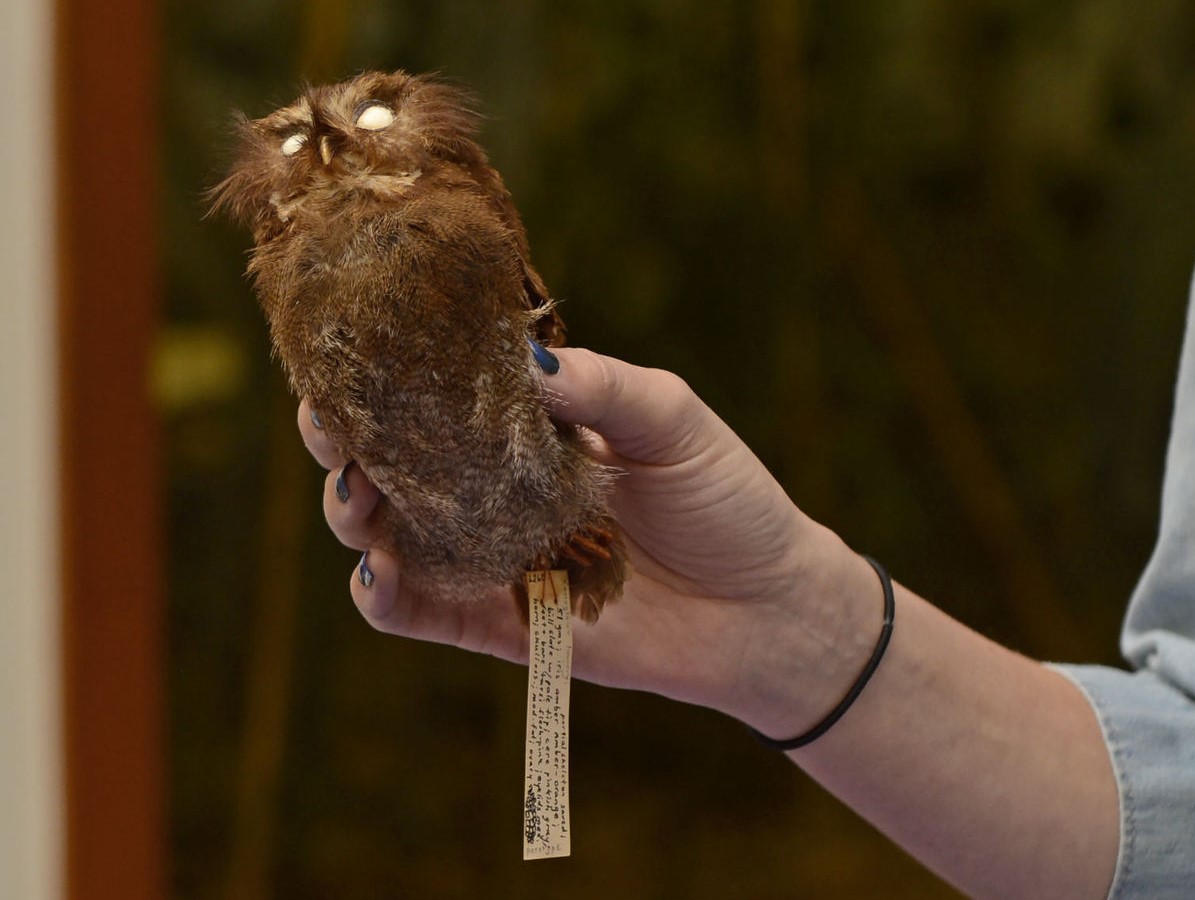By Jessie Salter
Linked paper: Extensive paraphyly in the typical owl family (Strigidae) by J.F. Salter, C.H. Oliveros, P.A. Hosner, J.D. Manthey, M.B. Robbins, R.G. Moyle, R.T. Brumfield, and B.C. Faircloth, The Auk: Ornithological Advances.
Every museum has its “greatest hits” tour — those specimens steeped in museum lore that you show off to visitors. As an LSU ornithology student, I learned early on that one of our greatest hits lies in a cabinet near the back corner of our collection: six specimens of the Long-whiskered Owlet (Xenoglaux loweryi), and a little red marker signifying the seventh lies in our holotype cabinet. As any LSU ornithologist should be able to tell you, this absurdly cute, tiny ball of fluff was discovered in Peru in 1976 by two LSU ornithologists, John O’Neill and Gary Graves, who knew immediately that it was unlike anything they had seen before (their recounting is well worth a read). They placed the new species in its own genus — Xenoglaux, meaning “strange owl” — and named it loweryi after the founder of the LSU Museum of Natural Science, George Lowery. It wasn’t until 2002, twenty-six years after its discovery, that LSU ornithologists finally managed to record the Long-whiskered Owlet song and collect samples for DNA extraction, the only such samples in the world for this elusive and mysterious species. Today, we have used some of those samples to answer to one of the outstanding mysteries surrounding the Long-whiskered Owlet, who its closest relatives are, and have revealed many surprises about owl evolution along the way.
The Long-whiskered Owlet is just one of a dozen monotypic (single-species) owl genera whose places in the bird family tree are uncertain, in large part due to the lack of available genetic material for these species, many of which have remote, insular distributions. By the time I started my PhD at LSU, decades of logistically challenging fieldwork by museum ornithologists at LSU, KU, and elsewhere had filled many of the sampling gaps with modern specimens and tissue samples, while advances in molecular techniques made it possible to generate DNA sequences from the toepads of historical museum specimens of those species we could not re-collect, including the extinct Laughing Owl (Sceloglaux albifacies). With supporting loans of tissues and toepads from eight museums, we used these new techniques to infer a genus-level phylogeny for owls, including the Long-whiskered Owlet and five other monotypic genera that had not been part of previous molecular phylogenetic studies. Little did we know that our work would reveal a new monotypic genus hiding in plain sight!
To better understand the relationships among owl genera, we included two species of barn owls (Tytonidae) and 45 species of typical owls (family Strigidae) representing all but one of the 28 genera of typical owls (although recent work found the remaining monotypic genus is actually part of the Athene clade). We collected thousands of nuclear ultraconserved element loci (regions of the genome that are shared among even distantly related taxa) using sequence capture, a technique that works well with degraded DNA from historical museum samples. Using a variety of analytical methods, we inferred a species tree of relationships among owl genera, many of which were previously unsupported by genetic data.
Our phylogeny has important implications for owl taxonomy (which is far more complicated than any of us realized before starting this project), but more broadly, it highlights patterns of morphological convergence and differentiation (species that look very similar despite not being closely related, and vice versa) that have obscured the evolutionary histories of many owl species. Spoiler alert: turns out many monotypic owl genera are just excellent examples of “island syndrome” and are actually nested within widespread genera. In contrast to this pattern, we also discovered two examples of remarkable morphological convergence that have resulted in misidentification at the genus level.
Forty-three years after its discovery, we now know that the Long-whiskered Owlet is most closely related to its tiny cousin, the monotypic Elf Owl (Micrathene whitneyi), just as O’Neill and Graves suspected. Far more surprising is our discovery that the closest relative of these two species is the Collared Owlet (Glaucidium brodiei), a species found throughout Southeast Asia that so closely resembles other Glaucidium that it was long considered part of a larger species complex! Together, the Collared Owlet, Elf Owl, and Long-whiskered Owlet form a distinct clade of typical owls, perhaps representing the last holdouts of a once-widespread lineage. In light of these results, we recommend the Collared Owlet be placed in its own genus, Taenioptynx. As with any good scientific discovery, however, our results lead to many more questions: how did this remarkable phenotypic convergence evolve, and are there other examples we have yet to discover?
These discoveries are not only ours to claim — they are the product of decades of work by ornithologists in the field and in research collections, and our results emphasize the importance of collaboration, scientific collecting, and making historical specimens available for genetic research. We’re in an exciting era for avian phylogenetics, as the OpenWings Project to build a UCE phylogeny with all 10,000+ bird species is underway. How many other “Collared Owlets” will we find with a complete phylogeny of all birds?
